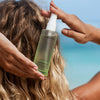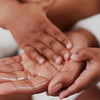First things first – all skin types are completely natural. Yours is an innate part of you that won’t suddenly change overnight, and it shouldn’t. That being said, we know that sometimes life in our bodies isn’t always going to be perfect. While our skin types stay the same, our skin’s day-to-day can be full of unpredictable moments or recurring patterns we don’t love, whether it’s the weather or a change in environment that’s having an impact. That’s what our Glow Academy series is here for; to give you the tools to understand your skin type, what’s affecting it, and how to help it to look and feel its very best.
It’s OILY SKIN’s turn in the spotlight! This skin type is all about delivering that daily natural glow – even if sometimes we wish it wouldn’t...
SO, WHAT EXACTLY IS OILY SKIN?

We may have been led to believe otherwise over the years, but oil is actually an innate ally to our skin. Whatever our skin type, our bodies produce an oil known as sebum which helps keep dryness at arm’s length and maintains skin’s moisture barrier. It just happens to be the case that for those with oily skin, the sebaceous glands up the ante and produce more sebum, causing extra shine and skin that feels greasy to the touch.
With this skin type, you’ll notice a consistent sheen throughout the day and will probably observe that your skin is quick to feel oily after a cleanse. We also all experience breakouts from time to time, but if you’re noticing spots starting to lay claim to permanent real estate on your face, it’s a strong sign of a naturally oily complexion. The excess sebum present with this skin type can lead to clogged pores, which is a surefire path to blemishes developing.
WHAT CAN HAVE AN IMPACT ON OILY SKIN?
We’re told constantly that cleansing is the way to keep our skin free of excess oil and dirt, so it seems natural for those with oily skin to cleanse more frequently, right? That’s actually an understandable mistake. The skin needs oil and when we over-cleanse, we strip it of the sebum that keeps it healthy, meaning that the sebaceous glands then overcompensate by producing even more. Sticking with a gentle cleanser twice a day is more than enough, so don’t feel like you have to keep one in your bag at all times to make a dash to the bathroom!
The myths just keep coming with this skin type, as it’s also a common misconception that moisturiser isn’t to be trusted. It makes sense – oil plus moisture doesn’t sound like the best of mixes on paper – but healthy skin needs the nourishing hydration that a moisturiser brings. Without it, the chances of a dryout are much higher, leading again to the unintended consequence of your body course-correcting by increasing oil production. Even those with the oiliest skin should still moisturise daily, opting for a light, non-occlusive option.
When it comes to diet, there are also some oily skin red flags. High-sugar snacks, dairy products, and foods that are rich in processed carbohydrates like white rice and white bread can send insulin hormones into a frenzy, which then increases the secretion of sebum.
HOW DO I TAKE CARE OF OILY SKIN?
- Steer your skincare to exfoliation station twice a week! The excess sebum on oily skin can mix with dead skin cells to create more layers of dirt which need to be broken down for a fresh complexion, and a gentle exfoliator is just the smoothing superstar for the job. Sweeping away congestion, deeply penetrating pores to clear them out and lifting away excess cell buildup – consider all the boxes of a healthy complexion ticked. Remember to make it a special guest in your routine though, as overindulging more than two to three times a week can damage capillaries close to your skin’s surface.
- Try to be as discerning as possible when you’re seeking out skincare. A lot of products which say they’re focused on reducing oiliness are formulated with harsh ingredients, with the intention to remove every last drop of oil they come across on your complexion. The results? You guessed it; disruption of the moisture barrier, dehydration and overcompensation of sebum production. Avoid products which use sulphates, alcohols and astringents, and your skin will thank you for it.
- They might sound like a very simple solution, but blotting papers exist for a reason. These over-the-counter quick fixes help to keep your shine at a minimum when used throughout the day to blot away excess oil. Just remember to pat instead of wiping if you’re wearing makeup to ensure a no-streak zone.
- Speaking of makeup, we recommend sticking to a mineral powder base, as liquid foundation long-wear options can clog pores and give a ‘caking’ effect. Not only can their non-comedogenic mineral siblings be continually layered throughout the day, they absorb excess oil and are great for sensitive skin to boot!
- We’ve said that you are what you eat, but for oily skin, what does that look like? Omega-3 and zinc are the ingredients that come up time and again as beneficial for this skin type, with the former’s high fatty acid content boosting the skin’s moisture barrier and the latter helping to regulate sebum production. The good news for you is that this dynamic duo can be found everywhere! Omega-3 levels are high in nuts, flaxseeds and chia seeds, while you can get your fill of zinc in legumes and wholegrains.
WHICH INGREDIENTS ARE GOOD FOR OILY SKIN?
Look out for skincare which features..
Hyaluronic acid – Unparalleled in its hydrating power while incredibly lightweight, it’s a key ingredient in the gentle moisturiser options that are so necessary for this skin type.
Clay – We’re particular fans of the Kaolin and green varieties! This earthy essential improves the appearance of pores and reduces shine by absorbing any excess oil.
Bio-retinol – A gentler derivative of the often irritating retinol, this helps to regulate oil levels by stimulating collagen production, which keeps pores tighter.
THE OILY SKIN FAQ
Does drinking water help oily skin? OK, time to debunk yet another myth. Oil doesn’t equal hydration, so even if your face feels as though it’s got enough moisture to last a lifetime, it’s perfectly possible that your skin is dehydrated. When this is the case, skin (as you’ve probably realised it’s wont to do) can overcompensate and decide to increase oil production. Having a regular intake of at least seven glasses of water a day staves off dehydration and keeps oily skin at a healthy balance.
Why does my nose seem to be more oily than the rest of my face? It’s completely natural! The sebaceous glands in the nose are some of the largest on your body, so the pores there have to be too in order to secrete the oil they produce. Sizing changes based on factors like genetics and age, but ultimately no matter what your skin type, the nose will always be one of your oiliest areas of skin.
Does oily skin impact signs of maturing skin? The larger pores and higher levels of sebaceous gland activity in this skin type have the potential to make the epidermis grow thicker. This results in increased collagen, which provides a bouncier, firmer texture to skin with less fine lines and wrinkles. So yes, there are certain signs of mature skin which accompany oily complexions less frequently, but they still don’t show much variation from the average when it comes to features like hyperpigmentation and skin texture.

 Skincare
Skincare
 Sale
Sale
 Bestsellers
Bestsellers
 Makeup
Makeup
 Body Care
Body Care
 Men's
Men's
 Hair Care
Hair Care
 Mama & Baby
Mama & Baby
















